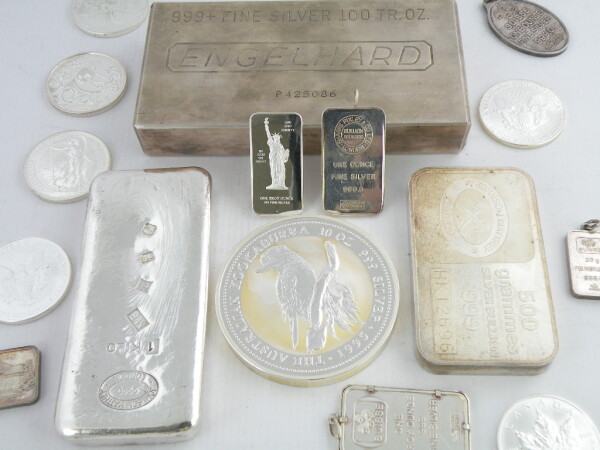What is Silver?
Silver is a soft, white metallic element with the chemical symbol Ag and is number 47 in the Atomic Table. Silver has decorative uses because of its’ malleable, ductile and lustrous properties. It has industrial uses that make benefit of its’ status as the most electrical conductive of any element and the most thermal conductive of any metal.

What is silver used for?
Silver has long been considered a precious metal and so is used for jewellery, table ware, cutlery and coins.
Due to its high conductivity, industrial applications of silver include its use for electrical contacts and conductors and so all mobile phones, computers etc each contain a tiny amount of silver. One of the biggest growth areas for silver usage in the 21st century has been in the production of solar panels. In addition, silver has many medical applications and is also used in the backing of mirrors. One of the prime uses of silver during the 20th Century was as silver nitrate used in photographic film. In the 1990's the photographic industry comprised 30% of consumed silver, however this use has decreased drastically in the digital age.
In the UK, the traditional unit for weighing precious metals is the troy ounce. The troy ounce is derived from the Roman monetary system. It differs from the avoir dupois ounce, which is the unit most people are familiar with on bathroom or kitchen scales, by being about 10% heavier.
A troy ounce can be converted from grams by dividing by 31.1 – e.g. 500 grams = 16.08 tr.oz.
You can convert to troy from avoir dupois ounces (kitchen scales) by multiplying by 0.911 – e.g 50 ounces (avoir dupois) = 45.55 troy ounces.
What is Fine Silver?
Fine silver is silver in its' pure form and is generally termed 999 silver – i.e. 99.9% pure. Fine silver is usually found in the form of grain, bars, ingots and investment coins.
What is Sterling Silver?
Sterling silver is 92.5% pure silver. Pure silver is brittle and so for making jewellery and articles of silver, copper and certain trace metals are added to make the Sterling alloy. The alloy is more malleable and easier to fashion that the pure metal.
What is the 'silver fix'?
The price of pure or fine bullion silver (999 grade) is fixed at midday on a daily basis (Mon-Fri) at the London Bullion Market. From 2018, this price is not permitted to be publicly advertised until 12 hours later, i.e. after midnight GMT.
What does 'spot price' mean?
The spot price is the value of silver at a moment in time. The spot price will change according to the buying and selling activities in the market.
What is silver plate?
Plate can be an ambiguous word in the context of silver. Traditionally the word "plate" was used to describe the silver owned by a household. This use of the word is now somewhat outdated and most people think of "plate" to mean items that are made of a base metal and covered with a thin coating of silver.
What is silver plating?
There are several forms of silver plating. In 1743, Thomas Bolsover discovered a method of fusing sheet silver to copper, items plated in this manner are now known as Old Sheffield Plate. Another form of fuse plating is known as Close plating and involved silver being fused to steel. Close plating was mostly used to give a decorative look to the blades of dessert cutlery.
Electroplating was invented in the in the 1830's and the Birmingham manufactory of Elkingtons took out a patent on the process in 1840. The article requiring a plate is suspended in a bath of silver potassium cyanide and connected to a rectifier. In the electrolytic process that follows, the article becomes the cathode and pure silver bars placed around the bath are the anodes. Silver is transferred from the anode through the electroplating solution and on to the cathode. The same principles of Elkington's silver electroplating process are still used today.
Electroplating was a huge commercial success and gave the middle classes an opportunity to own "plate" at a fraction of the price of Sterling silver. Within just a few years the Old Sheffield plating industry had been superseded by this less expensive alternative.
What does EPNS and EPBM stand for?
EPNS is an abbreviation of Electro Plated Nickel Silver. Nickel silver is an alloy of copper, nickel and zinc and is most widely used in the silver electroplating industry. The letters EPNS can be found on items such as spoons, forks, teapots, trays etc.
EPBM is an abbreviation for Electro Plated Britannia Metal. Britannia Metal was an inexpensive alloy containing mostly tin and is similar in composition to pewter. It is known as a "soft metal" and has proved not to be durable as it can corrode and perish.
Items bearing the letters EPNS (often shortened to EP) or EPBM have a much lower scrap value than solid silver, however we buy both in quantities of 50kg or more, n.b. we accept lower quantities if supplied in combination with a consignment of silver or gold.
Silver purities
999 (Fine silver)
The finest grade of silver to be found is 99.9% pure. The most common forms are bars, coins & grain. 999 coins and bars used for the investment market will be stamped 999 and are usually found as 1 tr.oz coins or in 100g, 500g or 1 kilo sizes. Certain minted coins such as the 1oz American Silver Eagle $1 coins are made from 999 fine silver and are described as bullion coins. We buy 999 grade bars and coins. We are also interested in buying 999 silver grain subject to XRF testing.
9584 (Britannia Standard)
Britannia Standard silver (95.84% pure) was introduced to England in 1697. It was the only standard available for making silver articles between 1697 and 1720, this was an attempt to limit the amount of coins that were being melted or clipped to be turned in to fashioned articles. It has since remained as a higher grade option for the making of British silver.
925 (Sterling silver)
Pure silver is too brittle and too soft for making jewellery and articles. Copper and certain trace metals are added to the silver to make the Sterling alloy of which a minimum of 92.5% is silver. The alloy is more malleable, hard wearing and easier to fashion than the pure metal.
The Sterling standard is the purity that has been used in the UK since mediaeval times for the manufacture of articles and jewellery. It was used for coinage from ancient times until the debasement in1920.
Sterling silver is the prime standard used in the USA, China, Japan, South Africa, Canada, Australia and many other Commonwealth countries.
830 Standard
This standard of silver is the most prevalent in northern Europe. For example in Sweden, Norway, Denmark and the Netherlands (2nd standard).
800 Standard
Much of the silver made in Germany, Italy and France (second standard) is 80% pure. This is considered by many to be the lowest acceptable grade for true silver articles. Lower grades 750, 720 and even 500 are used in some countries.
500 Standard
Following the debasement of the coinage in 1920 the 50% silver ratio came in to being. All UK "silver" coins made between 1920 and 1946 contain 50% silver. These coins were crown, half crown, florin, shilling, sixpence and three penny bit.
Other common standards
Prior to 1973, France used two standards of silver. 1st Standard was 950 pure, whereas the second standard was 800 pure.
The Netherlands had two standards of silver. 1st Standard was 933 pure and 2nd standard was 833 pure.
The most common Russian standard is 84 zolotniks – this equates to 875 purity.
The Austro-Hungarian empire used four standards of silver that were measured in lothige: 12 lothige = 750 standard, 13 = 800, 14 = 875 and 15 = 9375.
Portugal has two standards: 833 is the second standard with the premier standard being 916.
Coins
UK Coins (925 standard) pre-1921 - crown, half crown, florin, shilling, sixpence, groat (4d), three penny bit and 2d.
UK Coins (500 standard) 1921-1946 - crown, half crown, florin, shilling, sixpence, groat (4d), three penny bit and 2d.
US coins (900 standard) pre-1965 – Dollar, ½ dollar, quarter, dime.
US coins (400 standard) 1965–1970 – Dollar, ½ dollar.
